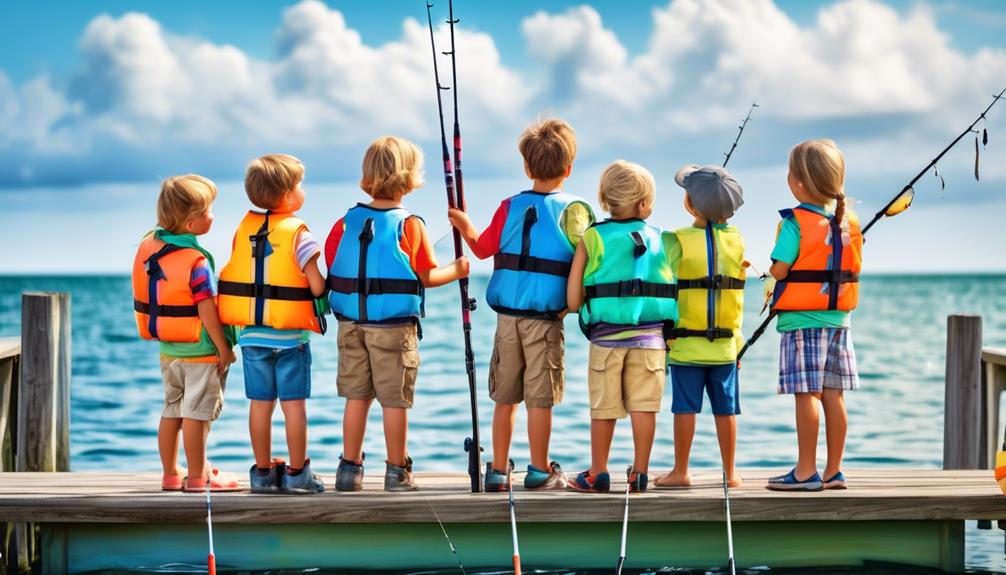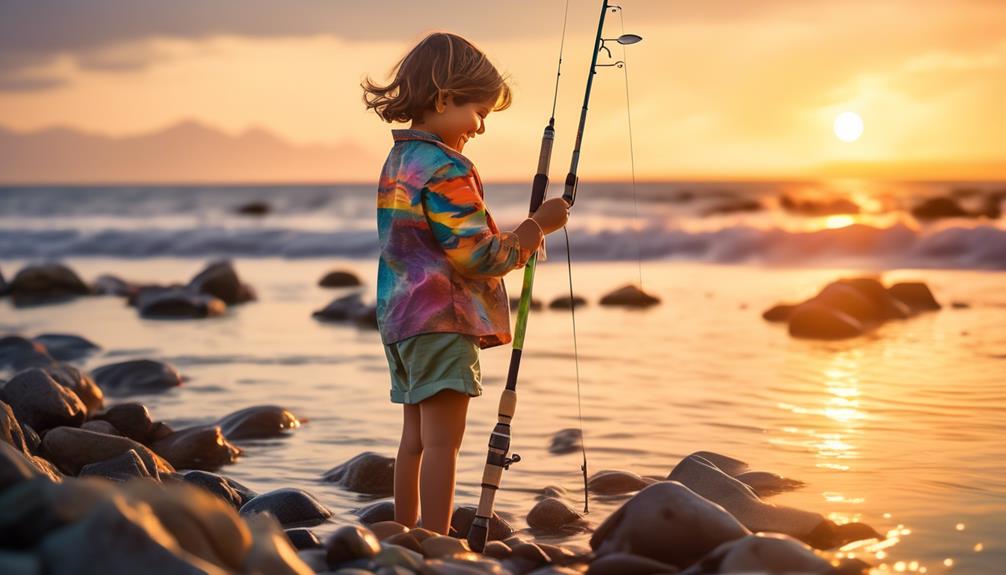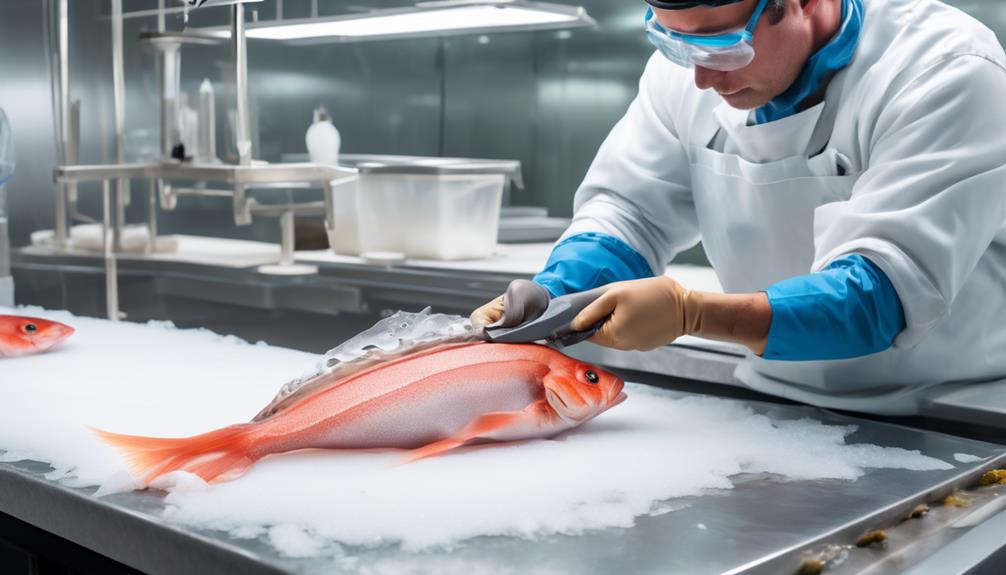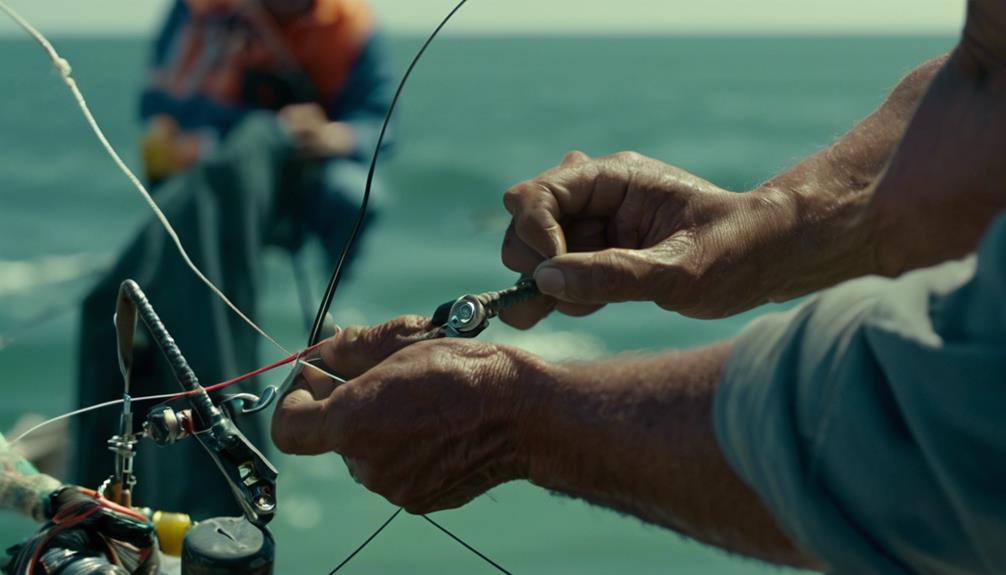As a parent, you want to give your child the opportunity to learn and explore new experiences.
Imagine the excitement on your kid's face as they reel in their first catch from the ocean.
But where do you start? What gear do they need? How do you ensure they stay safe?
This beginner guide to saltwater fishing for kids will provide you with the essential knowledge and tips to set your child up for a successful and enjoyable fishing experience in the ocean.
Whether it's their first time holding a fishing rod or they're looking to improve their skills, this guide will help your child become a proficient and responsible young angler.
Understanding Saltwater Fishing Basics
To begin saltwater fishing, you need to understand the basics of the activity, including the equipment and techniques required for success. Let's start with tackle selection.
When it comes to saltwater fishing, having the right tackle is crucial. Your tackle box should include a variety of hooks, sinkers, swivels, and lures. It's important to have a range of sizes and styles to adapt to different fishing conditions. For example, when targeting larger fish like tuna or marlin, heavy-duty tackle is necessary, while smaller fish like snapper may require lighter gear. Research the specific fish you're targeting to determine the most suitable tackle.
Now, let's talk about bait options. In saltwater fishing, live bait is often the most effective choice. Common live baits include shrimp, squid, and various small fish like mullet or sardines. Artificial lures can also be productive, mimicking the movement of prey to attract fish. Make sure to match your bait choice to the species you're aiming to catch. For instance, if you're going after bottom-dwelling fish, using cut bait like squid or strips of fish can be successful.
Understanding tackle selection and bait options is fundamental to your success in saltwater fishing. By having the right tackle and choosing the appropriate bait, you'll increase your chances of hooking that big catch. So, take the time to research and prepare your tackle box with the necessary gear, and select the best bait for the fish you're targeting.
These basics will set you on the right path for a rewarding saltwater fishing experience.
Essential Saltwater Fishing Gear for Kids
Now that you understand the basics of tackle selection and bait options for saltwater fishing, let's explore the essential gear that kids will need for a successful fishing adventure.
Tackle selection for kids should focus on simplicity and ease of use. A basic fishing rod and reel combo suitable for saltwater fishing is essential. Look for a lightweight and durable rod that's easy for kids to handle. A spinning reel is a good option for beginners as it's easy to cast and reel in.
In addition to the rod and reel, kids will need a tackle box to store their gear. Choose a small, kid-friendly tackle box with compartments for organizing hooks, sinkers, and lures. When it comes to fishing knots, it's important to teach kids a few basic knots that are easy to tie and effective for securing hooks and lures. The improved clinch knot and the Palomar knot are simple and reliable options for young anglers to learn.
Sun protection is crucial for a day of saltwater fishing, so make sure your kid has a hat, sunglasses, and sunscreen. Proper footwear, such as closed-toe shoes with good traction, is also important for safety on the boat or shore.
Lastly, don't forget a cooler with some snacks and drinks to keep your young angler fueled and hydrated throughout the fishing trip. With the right gear, kids can have an enjoyable and successful saltwater fishing experience.
Identifying Common Saltwater Fish Species
When saltwater fishing with kids, it's important to be able to identify common saltwater fish species to enhance the learning experience and increase the chances of a successful catch. Here are some tips to help you and your kids identify common saltwater fish species:
- Color and Markings: Many saltwater fish species have distinct color patterns and markings. For example, the red drum, also known as redfish, has a copper-colored body with a black dot near the tail. Teaching kids to recognize these patterns can make fish identification an exciting challenge.
- Body Shape and Fins: Point out the differences in body shapes and fin structures. For instance, the sleek body and long dorsal fin of a mahi-mahi are quite different from the stout body and triangular dorsal fin of a snapper.
- Habitat and Behavior: Discuss the specific saltwater habitats where certain fish species are commonly found. Explain that flounder, for instance, prefer sandy bottoms and are often found near structures like jetties or piers.
- Size and Weight: Highlight the typical size and weight of different species. This can be especially helpful for distinguishing between similar-looking fish. For instance, distinguishing between a juvenile and adult cobia based on size can be a fun learning experience.
Understanding fish identification and their habitats can make the fishing experience more educational and enjoyable for kids. It also promotes conservation by teaching them to respect and protect different species and their environments.
Safety Tips for Kids While Saltwater Fishing
Ensure your kids' safety while saltwater fishing by following these essential tips.
- When it comes to water safety, always ensure that your kids wear properly fitted life jackets when fishing from a boat or near deep waters. Even if they know how to swim, unexpected accidents can happen, so it's better to be safe than sorry. Additionally, constant supervision is crucial, especially if your kids are inexperienced or young. Always keep a close eye on them to prevent any accidents.
- Sun protection is also vital. Encourage your kids to wear hats, sunglasses, and sunscreen to protect themselves from the sun's harmful rays. Long-sleeved shirts and pants can also provide extra protection. Proper hydration is key, so make sure your kids drink plenty of water throughout the fishing trip to avoid dehydration, especially on hot days.
- Teach your kids about the potential dangers of handling sharp hooks, heavy fishing equipment, and slippery surfaces. Emphasize the importance of being cautious and using the appropriate safety measures when handling fishing gear.
- It's also essential to establish clear boundaries with your kids about where they can and can't go while fishing to prevent them from wandering into hazardous areas.
Learning Saltwater Fishing Techniques
To elevate your kids' saltwater fishing experience, guide them in learning essential fishing techniques that will enhance their skills and enjoyment of the sport. Mastering these techniques won't only increase their chances of a good catch but also foster a deeper appreciation for the art of fishing.
- Casting Techniques: Teach your kids the proper way to cast a line. Emphasize the importance of smooth, controlled movements to achieve greater distance and accuracy. Show them how to release the line at the right moment for optimal bait placement.
- Knot Tying: Knowing how to tie secure and reliable knots is crucial in fishing. Teach them fundamental knots like the improved clinch knot for attaching the hook, the Palomar knot, and the loop knot for lures. Practice is key to mastering these skills.
- Bait Selection: Understanding the types of bait and when to use them is vital. Explain the differences between live bait, artificial lures, and cut bait. Teach them to observe the environment and consider the behavior of the fish to make informed decisions about bait selection.
- Fish Behavior: Educate your kids about the behavior of different fish species. Discuss how factors like water temperature, tide, and time of day impact fish activity. Encourage them to observe fish movements and feeding patterns to improve their chances of a successful catch.
Best Practices for Catch and Release
What are the most effective methods for safely releasing a fish back into the water after catching it? Proper fish handling is crucial for the fish's survival after catch and release.
Always wet your hands before handling a fish to prevent the removal of its protective slime layer, which can make the fish more susceptible to diseases. Additionally, avoid touching the fish's gills or eyes as these are very delicate areas.
When removing the hook, do it quickly and efficiently to minimize fish stress. If the fish is hooked deeply, consider cutting the line instead of attempting to remove the hook, as this can cause less harm. It's important to note that leaving a hook in a fish's mouth will eventually rust away harmlessly.
Consider the environmental impact when fishing. Use barbless hooks to minimize damage to the fish's mouth, making hook removal easier and less stressful. If you must handle the fish, hold it gently and avoid squeezing it. Keep the fish in the water while removing the hook to reduce stress.
Always release the fish as soon as possible after catching it. Once the fish has recovered from the fight, gently place it in the water and hold it by the tail until it swims away on its own.
Fun Saltwater Fishing Activities for Kids

After mastering the best practices for catch and release, kids can now engage in a variety of fun saltwater fishing activities, fostering their love for the sport and the marine environment.
- Fishing Knot Tying: Teach your kids how to tie basic fishing knots like the improved clinch knot and the Palomar knot. This not only helps them become more independent anglers but also enhances their fine motor skills.
- Ocean Conservation: Encourage kids to participate in beach cleanups or marine conservation projects. This hands-on experience will instill a sense of responsibility towards the marine environment and its inhabitants.
- Species Identification: Make a game out of identifying different fish species. Create flashcards with pictures and facts about various saltwater fish, and have your kids match the fish to the correct name and information.
- Nature Scavenger Hunt: Turn a fishing trip into a nature scavenger hunt by creating a list of marine life and coastal elements for kids to spot. This not only adds an element of fun to the fishing experience but also educates them about the diverse marine ecosystem.
Engaging in these activities won't only make saltwater fishing more enjoyable for kids but also help them develop important skills and a deeper appreciation for the marine environment.
Cleaning and Preserving Your Catch
Before heading home with your catch, it's essential to know how to properly clean and preserve your fish to maintain its quality and taste. Proper fish handling and storage are crucial to ensure that your saltwater catch remains fresh and delicious.
When it comes to saltwater fish preservation, techniques such as gutting and cleaning the fish as soon as possible after catching it can significantly impact the quality of the meat. This involves removing the entrails and washing the fish with clean water to prevent spoilage. It's important to keep the fish cold, either by placing it on ice or in a cooler, to slow down the growth of bacteria.
Once you've returned home, it's important to further preserve your catch. One effective method is to fillet the fish and then freeze it. Freezing the fish as soon as possible helps maintain its freshness. Make sure to wrap the fillets tightly in plastic wrap or vacuum-sealed bags to prevent freezer burn.
Another preservation method is to brine or salt the fish, which can help enhance its flavor and extend its shelf life. You can also consider smoking the fish, which not only preserves it but also imparts a delicious smoky flavor.
Regardless of the preservation method you choose, always follow safe food handling practices to ensure that your catch remains safe to eat.
Frequently Asked Questions
Can Kids Use Any Type of Fishing Rod and Reel for Saltwater Fishing, or Are There Specific Ones Designed for Beginners?
You can use any fishing equipment for saltwater fishing, but specific ones designed for beginners work best. Kids can benefit from lighter, more manageable rods and reels that are easier to handle and learn with.
Are There Any Special Regulations or Rules That Kids Need to Be Aware of When Saltwater Fishing?
When saltwater fishing, kids need to be aware of special regulations and rules. It's important to follow guidelines for catch limits, protected species, and fishing areas. Always check local regulations to ensure a fun and responsible fishing experience.
What Are Some Common Mistakes That Beginners Often Make When Saltwater Fishing, and How Can Kids Avoid Them?
When saltwater fishing, beginners often make common mistakes like using the wrong equipment and not understanding rod and reel requirements. To avoid these, kids should learn proper gear usage and familiarize themselves with equipment specifications.
How Can Kids Learn to Properly Handle and Release Fish to Ensure Their Survival After Catching Them?
To properly handle and release fish, kids should support the fish gently, avoid touching their gills, and quickly return them to the water. This ensures fish survival and supports conservation efforts through catch and release practices.
Are There Any Specific Techniques or Tips for Helping Kids Stay Patient and Focused While Waiting for a Bite While Saltwater Fishing?
When saltwater fishing, patience training and focus techniques are crucial for kids. Engage them in activities like storytelling or mindfulness exercises to keep them focused and patient while waiting for a bite.
Conclusion
Now that you've learned the basics of saltwater fishing, you're ready to hit the waters and start reeling in some big catches! Remember to stay safe, use the right gear, and practice good fishing techniques.
And don't forget to have fun and enjoy the experience of being out on the water. Happy fishing, kid!



